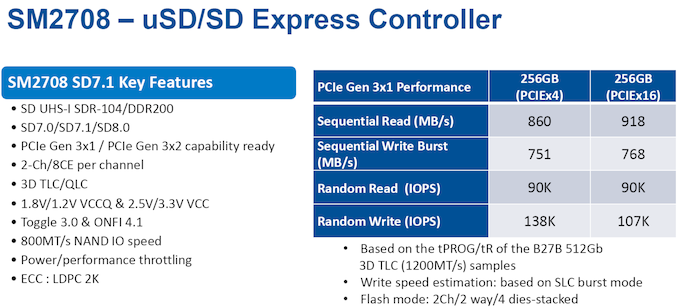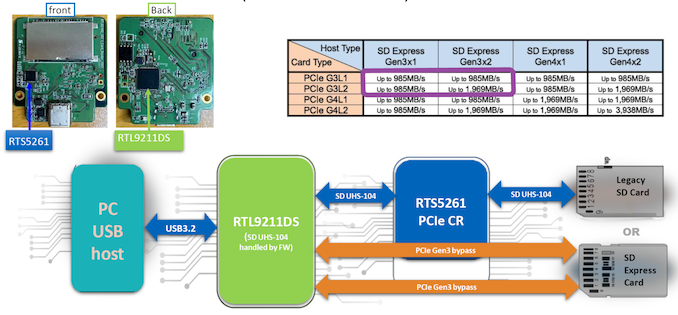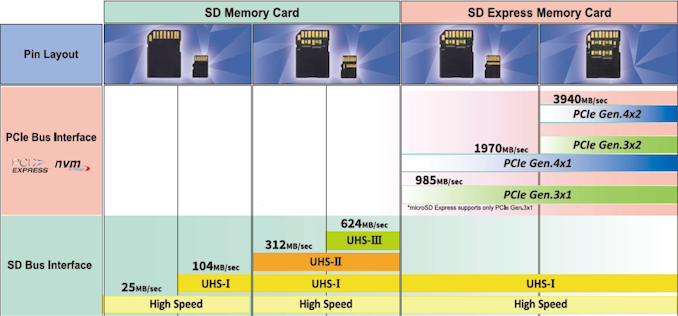Next Gen NVMe SD Card Review: The SM2708 Controller Serves it Hot and Fast
by Ganesh T S on September 9, 2021 9:00 AM EST- Posted in
- Storage
- NAND
- flash
- NVMe
- Silicon Motion
- Memory Cards
- 3D TLC
- SD Express

Flash-based removable media, such as SD cards, have a host of use-cases in products ranging from content capture devices to portable game consoles. Many computing systems (including PCs and smartphones) also employ them to augment the available storage capacity. There are two main standards bodies in this segment - the SD Association (SDA) and the CompactFlash Association (CFA), with the SDA is responsible for the Secure Digital cards (SD / microSD), and the CFA has the CompactFlash and CFast card markets.
The products currently servicing this market segment are based on technology standards drafted when SATA was the pinnacle of internal storage performance, but in fact both standards bodies jumped on to the NVMe bandwagon in the late 2010s. Removable memory cards based on PCIe / NVMe are slowly starting to appear in the market - CFexpress from CFA, and SD Express from the SDA. Both ADATA and Lexar have announced plans to launch their SD Express cards within the next few quarters. The cards from both vendors are based on the Silicon Motion SM2708 controller.
Silicon Motion sampled us its SM2708 reference design (with a 250GB capacity) to put through our rigorous memory cards evaluation suite. This review takes a detailed look at the performance of the card in conjunction with Realtek's RTL9211DS card reader reference design. It also serves as a preview of what consumers can expect from SD Express cards appearing in the market over the next few quarters.
Lets Go: The Rise of PCIe and NVMe
SD cards and CompactFlash cards have emerged as the storage media of choice for content capture devices such as digital cameras and camcorders. SD cards have also enjoyed support in the portable game console space and as boot drives for single-board computers. Currently popular SD and CF cards are based on standards developed when SATA ruled the roost as the transfer protocol of choice for internal storage devices.
As PCIe-based NVMe took the SSD storage market by storm, both the SDA and CFA introduced removable card standards based on PCIe. The CFA had actually jumped on to PCIe quite early, with a 1Gbps standard in 2011 - the XQD card format. However, lack of backwards compatibility with existing CompactFlash readers meant that the format never really took off despite making its way into retail. While the original CF cards were based on PATA (the precursor to SATA), a faster version based on SATA was introduced in 2009 as CFast. In 2016, the CFA announced plans for the CFexpress standard and it was published in mid-2017. CFexpress cards retain the XQD form-factor, and a few CFexpress cards are already in the market.
SD cards are also popular in multiple market segments. In order to serve the needs of all serviced markets, the SD Association introduced the NVMe-based SD Express standard (SD 7.0) in 2018, with a SD 8.0 follow-up in 2020. SD cards as well as card readers based on these new standards have been making the rounds at various trade shows since 2019. However, none went on to appear in the retail market. That is about to change in the coming months, with both ADATA and Lexar announcing plans to launch their SD Express cards based on the Silicon Motion SM2708 card controller within the next few quarters.
What We're Testing Today: SD 7.1 Reference Designs
Consumers need both SD Express cards and card readers in order to take advantage of all the benefits of PCIe / NVMe in the SD form-factor. While SD Express cards are being enabled by controllers such as the SM2708, card readers platforms based on JMicron and Realtek have also appeared in various trade-shows (such as the RTS5261 demonstrated at Computex 2019). Silicon Motion coordinated with Realtek to sample their 250GB SM2708 reference design along with a card reader based on the the Realtek RTL9211DS and RTS5261 for this review.
The Silicon Motion SM2708 card controller supports both SD UHS-I and PCIe Gen 3.0 x2 on the upstream side. On the flash side, both Toggle 3.0 and ONFI 4.1 NAND interfaces at 800 MT/s are supported. The controller is restricted to two-channel operation with 8 enables per channel, and both 3D TLC and QLC can be used.
Silicon Motion has qualified the SM2708 for operation with SanDisk / Kioxia 96L TLC (2-plane flash) and Micron B27B (96L) and B47R (176L) (both 4-plane flash). With 4 plane flash, Silicon Motion claims write performance of more than 700 MB/sec with four NAND flash pieces. The write performance is highly influenced by the number of flash pieces, NAND tPROG, and plane numbers.
The 250GB reference design sampled for review comes with the SanDisk / Kioxia BiCS 4 96L TLC 2-plane flash.
The Realtek card reader is a dual-chip solution that uses the RTL9211DS and RTS5261. The RTL9211DS is more commonly seen in storage bridges that enable M.2 NVMe SSDs to be used with a USB host. It has a USB 3.2 Gen 2 (10 Gbps) upstream interface, and a PCIe 3.0 x2 downstream interface.
In the card reader, the functionality is the same - in SD Express mode, the PCIe lanes directly connect to the SD card pins (with the RTS5261 PCIe pins acting in bypass mode). However, in legacy mode, the UHS-I interface operation is implemented with the RTS5261, and the RTL9211DS only acts as a host interface component. The communication between the RTL9211DS and the RTS5261 is handled via firmware in this case.
The SD Express Standard
The SDA's SD Express standard aims to facilitate the manufacturing of removable cards in the legacy SD and microSD form-factors while retaining basic backwards compatibility. Towards this, the SD Express cards support both the PCIe / NVMe interface, as well as the UHS-I interface.
The pin layout of the SD Express cards are similar to that of UHS-II cards. Depending on the host capabilities, the card controller can switch between legacy SD UHS-I or NVMe modes. The card controller recognizes the host's capabilities based on the supply voltage - PCIe / NVMe requires a 1.8V supply and uses both rows of pins on the card, while the legacy mode is the default and uses only the top row of pins for data transfer. It must be noted that SD 8.0 introduced in 2020 allows for a third row of pins for supporting a second PCIe lane. Due to form-factor limitations, microSD Express doesn't support the two-lane feature.
While initialization may be in either mode, accessing through PCIe enables the card to present itself as a standard NVMe device to the host. This is especially relevant to our evaluation scheme, as S.M.A.R.T access via NVMe allows for temperature tracking and card health monitoring among other features.
Testbed Setup and Evaluation Methodology
Direct-attached storage devices (including SD Express cards) are evaluated using the Quartz Canyon NUC (essentially, the Xeon / ECC version of the Ghost Canyon NUC) configured with 2x 16GB DDR4-2667 ECC SODIMMs and a PCIe 3.0 x4 NVMe SSD - the IM2P33E8 1TB from ADATA.
The most attractive aspect of the Quartz Canyon NUC is the presence of two PCIe slots (electrically, x16 and x4) for add-in cards. In the absence of a discrete GPU - for which there is no need in a DAS testbed - both slots are available. In fact, we also added a spare SanDisk Extreme PRO M.2 NVMe SSD to the CPU direct-attached M.2 22110 slot in the baseboard in order to avoid DMI bottlenecks when evaluating Thunderbolt 3 devices. This still allows for two add-in cards operating at x8 (x16 electrical) and x4 (x4 electrical). Since the Quartz Canyon NUC doesn't have a native USB 3.2 Gen 2x2 port, Silverstone's SST-ECU06 add-in card was installed in the x4 slot. All non-Thunderbolt devices are tested using the Type-C port enabled by the SST-ECU06.
The specifications of the testbed are summarized in the table below:
| The 2021 AnandTech DAS Testbed Configuration | |
| System | Intel Quartz Canyon NUC9vXQNX |
| CPU | Intel Xeon E-2286M |
| Memory | ADATA Industrial AD4B3200716G22 32 GB (2x 16GB) DDR4-3200 ECC @ 22-22-22-52 |
| OS Drive | ADATA Industrial IM2P33E8 NVMe 1TB |
| Secondary Drive | SanDisk Extreme PRO M.2 NVMe 3D SSD 1TB |
| Add-on Card | SilverStone Tek SST-ECU06 USB 3.2 Gen 2x2 Type-C Host |
| OS | Windows 10 Enterprise x64 (21H1) |
| Thanks to ADATA, Intel, and SilverStone Tek for the build components | |
The testbed hardware is only one segment of the evaluation. Over the last few years, the typical direct-attached storage workloads for memory cards have also evolved. High bit-rate 4K videos at 60fps have become quite common, and 8K videos are starting to make an appearance. Game install sizes have also grown steadily even in portable game consoles, thanks to high resolution textures and artwork. Keeping these in mind, our evaluation scheme for memory cards involves multiple workloads which are described in detail in the corresponding sections.
- Out-of-the-box performance using CrystalDiskMark and fio Sequential Access workloads
- Extended usage simulation using custom robocopy workloads and real-world access traces using PCMark 10's storage benchmark
- Long-term usage effects evaluation using CrystalDiskMark and fio Sequential Access workloads
- Performance restoration testing
The SM2708 reference design was evaluated in two modes - one using the Realtek card reader in SD Express mode, and another using the Lexar Professional Workflow SR2 SDHC / SDXC UHS-II USB 3.0 Reader (used in our standard evaluation of SD / uSD cards) in UHS-I mode. The remaining sections in this review will cover the performance of the card in both these modes along with some observations on power consumptions and thermals.















43 Comments
View All Comments
eastcoast_pete - Thursday, September 9, 2021 - link
Those temperatures and power draws are way too high for what is probably the main use scenario: removable storage in high-resolution handheld cameras. They're also too high for potential use as removable storage, again mainly for video, in future Smartphones, once Android counterparts to Apple's upcoming iPhone Pro Max become available. That can reportedly use ProRes as file format to save videos, and ProRes eats storage space for breakfast.bananaforscale - Thursday, September 9, 2021 - link
Temps are certainly too high, but power draw not necessarily. That peak draw of 4.58W is ~1.1A at 4.2V, so you could power one off a single 18650 cell for a couple of hours assuming peak is constant, which it won't be.Fulljack - Thursday, September 9, 2021 - link
I think it's more intended for state-of-the-art digital camera that output high bitrate, high resolution video. one of the limiting factor are storage speed. having this on what seems like a laptop on your shoulders would help portability a lot.at_clucks - Friday, September 10, 2021 - link
At that point many users simply invest in cameras that output to an external SSD, at least with something like a CFast to SSD adapter.schuckles - Friday, September 10, 2021 - link
Whether these cards are usable as is really depends on your workload. I would have liked to see something like the anadrech light benchmarked and include the MBPS/watt to know how realistic that 4 watt workload is. Also curious what the idle/standby power of the card itself is.PaulHoule - Thursday, September 9, 2021 - link
How much heat could you remove from that kind of thing if you made the exterior out of metal and pressed it between two cold plates with a strong spring? I'd like to give an SDExpress card the same treatment as the "CPU" on an IBM 3090.shelbystripes - Thursday, September 9, 2021 - link
So… CFExpress cards are stupid fast, but get hot just doing sustained read (copying a full 256GB card’s contents to a computer all at once). And this is putting the same thing in an even smaller form factor. Of course the end result is inevitable.For photography this is still valuable, the cards are fast enough even in UHS-I mode for sustained burst in most cameras, and then having PCIe speeds for clearing the contents quickly to a PC is quite handy. But for video… these things will get hot, and compact camera thermals are already a nightmare. The Canon EOS R5 can technically shoot 8K video, but do it for very long and the damn thing overheats. The more you add awful thermal properties inside a compact environment like that, the worse off you are…
spaceship9876 - Thursday, September 9, 2021 - link
you forgot to mention ufs cards.Einy0 - Thursday, September 9, 2021 - link
Wow, 96C that will leave a mark!Kamen Rider Blade - Thursday, September 9, 2021 - link
When are regular sized SD cards going to go up in size?1TB Micro SD Cards already exists.
I calculate that if you make optimal use of the physical space of a SD card, you can get 4.5 TiB of storage using existing 512 GiB Nand Flash cells.
Wouldn't you want an entire regular sized SD card with 4.5 TiB of storage?